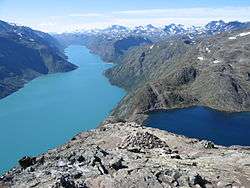Gjende
| Gjende | |
|---|---|
 Lake Gjende to the left, as seen from Besseggen, looking in the direction of Memurubu and Gjendebu. Lake Bessvatnet to the right. | |
| Location | Oppland |
| Coordinates | 61°29′22″N 08°40′48″E / 61.48944°N 8.68000°ECoordinates: 61°29′22″N 08°40′48″E / 61.48944°N 8.68000°E |
| Primary inflows | River Muru |
| Primary outflows | River Sjoa |
| Basin countries | Norway |
| Max. length | 18 km (11 mi) |
| Max. width | 1.25 km (0.78 mi) |
| Surface area | 15.64 km2 (6.04 sq mi) |
| Average depth | 64 m (210 ft) |
| Max. depth | 149 m (489 ft) |
| Water volume | 1,030×103 m3 (36×106 cu ft) |
| Shore length1 | 40.32 km (25.05 mi) |
| Surface elevation | 983.7 m (3,227 ft) |
| 1 Shore length is not a well-defined measure. | |

Gjende (or Gjendin) is a lake in the Jotunheimen mountains in Norway's Jotunheimen National Park. The proglacial lake shows typical characteristics of glacial formation, being long and narrow, with steep walls—18 km in length and only 1.5 km in width at the broadest point. Gjende has a characteristic light-green color resulting from the large quantity of rock flour which is discharged into the Gjende by the Muru river. The river Sjoa provides the outlet from Gjende at Gjendesheim, and flows eastward into the Gudbrandsdalslågen river.
Gjende lies in the middle of Jotunheimen National Park and both to the north and south of the lake lie peaks greater than 2,000 m. There are numerous staffed tourist cabins maintained by the Norwegian Mountain Touring Association (DNT); in the west end lies Gjendebu, on the north side lies Memurubu and on the east end lies Gjendesheim. In the summer boats provide transport between these locations.
Name
The name (Old Norse *Gendir) is derived from Norse gandr m 'staff, stick'. This is referring to the form of the long and narrow lake.
See also Bygdin
Cultural and literary references
Lake Gjende is found in literature and travel books from the 18th century. Together, the Jotunheimen lakes of Gjende and Bygdin play in many such descriptions. For example, Henrik Ibsen's Peer Gynt took his famous wild-reindeer ride along "the Gjendin Ridge", a reference to either the narrow Besseggen Ridge - or the Knutshø ridge on the other side of lake Gjende.
The official name Gjende is taken from the Gudbrandsdal traditional district dialect used in Lom and Vågå. In the Vang dialect the lake is called Gjendin, which is the form you find in Henrik Ibsen's name for what is now called Besseggen, formerly Gjendineggen, or Gendineggen in the older orthography. The name Gjende is derived from the old Norse word "gandir" that can be translated into "straight stick", whereas the lake to the south Bygdin can be translated as "bent stick", the two names thereby referring to the shape of the lakes.
The lake gave its name to a famous early outdoors man and free thinker, Jo Gjende (1794—1884), who had a cabin at Gjende.
 Lake Gjende as seen from Gjendesheim.
Lake Gjende as seen from Gjendesheim. Panoramic view on the Gjende lake near Gjendesheim
Panoramic view on the Gjende lake near Gjendesheim Besseggen seen from the east, with Gjende lake to the right and Bessvatnet to the left
Besseggen seen from the east, with Gjende lake to the right and Bessvatnet to the left Camping at Gjende lake.
Camping at Gjende lake.
 Panoramic view over Gjende lake near Memurubu
Panoramic view over Gjende lake near Memurubu
External links
| Wikimedia Commons has media related to Gjende. |
- Lake depth map of Gjende (Norwegian)
- Gjendebåtane - "To the heart of Jotunheimen by boat"
- Gjendesheim
- Gjendebu
- Memurubu (Norwegian only)